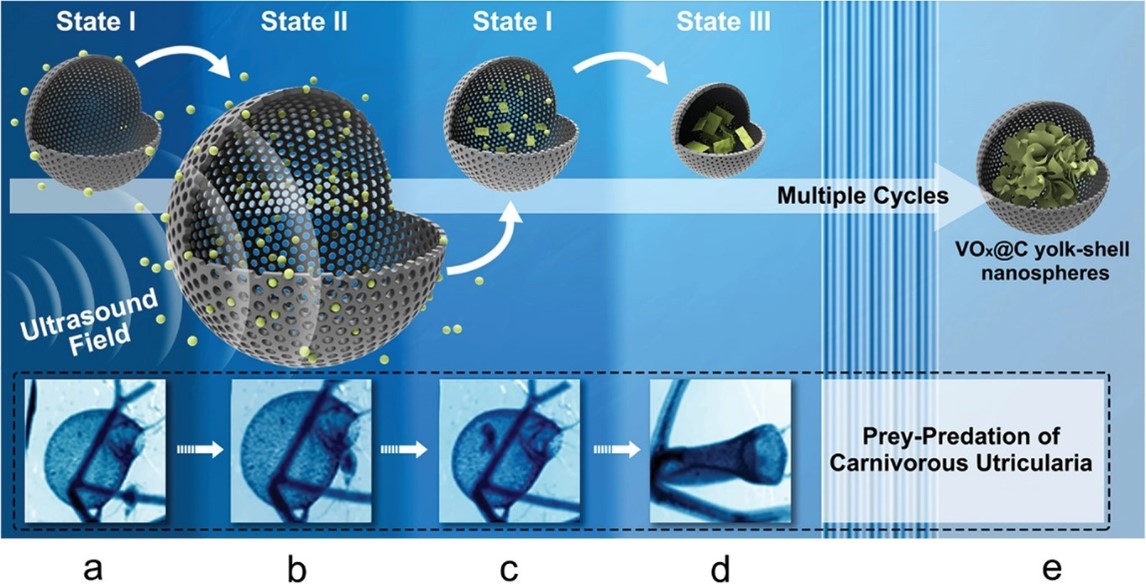Insectivorous plants are a special group in the plant kingdom. They can be autotrophic by photosynthesis and catch insects to supplement the nutrition they need. In different living environments, different insectivorous plants have evolved different insect trapping habits. Among them, the aquatic insectivorous plant named Utricularia evolved a prey–predation capacity, which uses the rapid expansion of its micro-cystic chamber to generate pressure to prey on insects. This delicate structure ensures that it can survive in an environment lacking such nutrients as N and P. Inspired by the predatory behavior of Utricularia with pressure difference, researchers from the School of Physics Science and Engineering of Tongji University cooperated with their counterparts from the School of Automotive Studies in biomimicking prey–predation of carnivorous Utricularia through cavitation effect of vesicles with spheres under ultrasonic field. They realized the active encapsulation of mesoporous carbon spheres on vanadium oxide nanoparticles to avoid the harsh high-temperature reduction process. The preformed VOx@C yolk-shell nanospheres were applied to the separator of lithium sulfur (Li-S) batteries. Through the encapsulation and catalytic conversion of polysulfide, the shuttle effect of polysulfide was effectively suppressed, and high-performance Li-S batteries was prepared. On September 30, a paper based upon this research entitled "Biomimetic Synthesis of VOx@C Yolk-Shell Nanospheres and Their Application in Li-S Batteries" was published in Advanced Functional Materials, a leading academic journal in international material science.

Figure 1. Synthesizing VOx@C yolk-shell nanospheres by biomimicking prey–predation of carnivorous Utricularia (illustrations: states of preying Utricularia)
The research team discovered that hollow mesoporous carbon spheres (HMCS) have high intrinsic frequency and superior mechanical properties. Driven by ultrasonication, HMCS can maintain its integrity, and expand and contract rapidly and asymmetrically, resulting in a huge periodic pressure difference inside and outside the spheres. At the same time, the relative motion between the mesoporous tunnel in the HMCS and VOx nanoparticles will produce a damping force, and the asymmetric expansion and contraction process will make the damping force of nanoparticles entering the carbon spheres smaller than when they escape. Therefore, contrary to the self-heating mechanical process, under the continuous input of ultrasonication, mesoporous carbon spheres encapsulate vanadium oxide nanoparticles into the sphere in reverse concentration gradient to synthesize VOx@C. Experiments and numerical calculations show that this process is consistent with the pre-predation process of Utricularia. In addition, by controlling the ultrasonication process, the material can grow on the surface or inner surface of the carbon sphere.
The material is used as a regenerative polysulfide -scavenging layer (RSL) for high loading Li-S batteries in the separator, which effectively inhibits the shuttle effect of lithium polysulfide. As compared with cells with a commercial Celgard polypropylene (PP) separator, those with a RSL has greatly improved its capacity retention (from 467 to 860 mAh g−1 after 100 cycles) and magnification performance or superior rate capability (from 30 to 540 mAh g−1 at 5 C current density).
The research provides a new physical way to develop the synthesis of yolk-shell materials, effectively avoiding the traditional preparation of yolk-shell materials at high temperature and high pressure as well as the low reuse of raw materials. It can also be used to encapsulate other oxides inside the mesoporous carbon shell, such as WO3, CeO2 and Nb2O5. This technology has huge potential in energy storage and conversion devices and reasonable design of heterostructures.
The first author of this paper is JI Mingze, a doctoral student in the School of Physics Science and Engineering and NI Jie, a doctoral student in the School of Automotive Studies. The corresponding authors are GAO Guohua, associate professor of the School of Physics Science and Engineering, WU Guangming, and XIAO Qiangfeng, professor of the School of Automotive Science. All of them are from Tongji University. The research was supported by the National Natural Science Foundation of China and Shanghai Social Development Science and Technology Research Project of 2020 "Science and Technology Innovation Action Plan".
Paper link: https://onlinelibrary.wiley.com/doi/10.1002/adfm.202206589